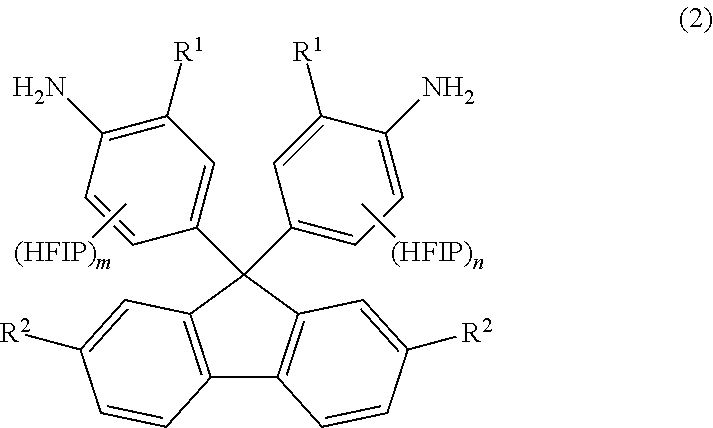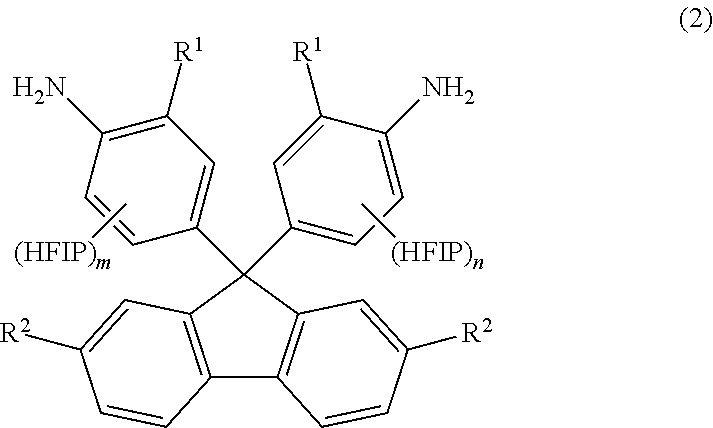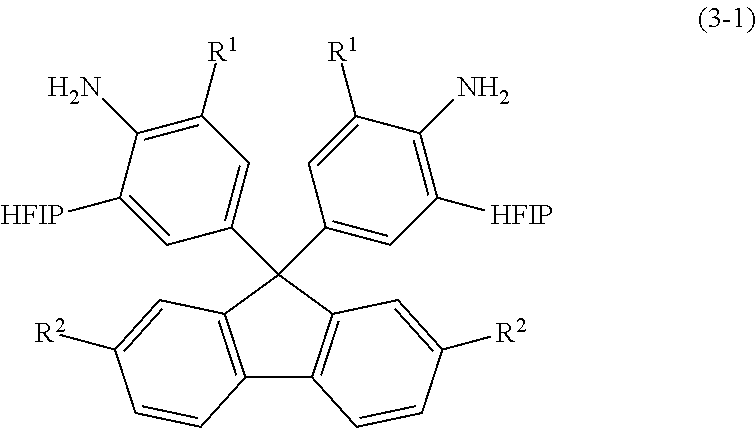Fluorine-Containing Polymerizable Monomer And Polymer Compound Using Same
a technology of fluorene and polymer compound, which is applied in the direction of polyamide coating, organic chemistry, coating, etc., can solve the problems of low moldability, low solubility of polymers in organic solvents, and inability to produce relatively low heat-resistant display parts in the above molding process
- Summary
- Abstract
- Description
- Claims
- Application Information
AI Technical Summary
Problems solved by technology
Method used
Image
Examples
example 1
Synthesis of HFIP-Containing Fluorenediamine of Formula (22) (FHIP-FL)
[0126]Into a 300-mL autoclave, 9,9-bis(4-aminophenyl)fluorene (25 g, 0.072 mol; available from Tokyo Chemical Industry Co., Ltd.), hexafluoroacetone trihydrate (70 g, 0.32 mol) and paratoluenesulfonic acid monohydrate (0.68 g, 3.6 mmol) were placed. The autoclave was sealed. The resulting reaction solution inside the autoclave was stirred for 17 hours while the autoclave was heated at 130° C. in an oil bath. Then, the autoclave was cooled down to room temperature. (The term “room temperature” refers to a temperature of atmosphere without heating or cooling and generally ranges from about 15 to 30° C. The same applies to the following.) To the reaction solution, toluene (50 g) was added. The thus-formed solid was filtered out, washed with water and further washed with chloroform (100 ml). The washed solid was filtered out and dried under vacuum. There was thus obtained a white powder (11.6 g, 0.017 mol, yield: 25%)...
example 2
Synthesis of HFIP-Containing Fluorenediamine of Formula (23) (HFIP-MeFL)
[0129]Into a 300-mL autoclave, 9,9-bis(4-amino-3-methylphenyl)fluorene (70 g, 0.186 mol), hexafluoroacetone trihydrate (220 g, 1.000 mol) and paratoluenesulfonic acid monohydrate (1.77 g, 9.3 mmol) were placed. The autoclave was sealed. The resulting reaction solution inside the autoclave was stirred for 24 hours while the autoclave was heated at 130° C. in an oil bath. Then, the autoclave was cooled down to room temperature. To the reaction solution, methanol (200 mL) was added. The thus-formed solid was filtered out and washed with chloroform (100 ml). The washed solid was filtered out and dried under vacuum. There was thus obtained a white powder (15.2 g, 0.022 mol, yield: 20%). It was confirmed by NMR analysis that the white powder was HFIP-containing fluorenediamine of the formula (23) (sometimes referred to as “HFIP-MeFL”).
[NMR Analysis]
[0130]1H-NMR (DMSO-d6): δ 10.11 (brs, 2H), 7.86 (d, J=7.2 Hz, 2H), 7.3...
example 3
Synthesis of Polymer P1 by Polymerization of HFIP-FL and 6FDA
[0132]Into a 300-mL three-neck flask, HFIP-FL (10.01 g, 14.7 mmol), 4,4′-(hexafluoroisopropylidene)diphthalic anhydride (sometimes referred to as “6FDA”; 6.533 g, 14.7 mmol) and N,N-dimethylacetamide (38.57 g) were placed. The resulting reaction solution was stirred at room temperature for 18 hours under an atmosphere of nitrogen, and then, dropped into a mixed solvent of water and methanol (mixing volume ratio 1:1). The thus-formed white precipitate was recovered by filtration and dried under vacuum at room temperature for 12 hours. There was thus obtained a polymer P1 (yield: 14.89 g, 90%). It was confirmed by GPC measurement that the molecular weight Mw of the polymer P1 was 51,000. In the following scheme, n represents the number of repeating units (the same applies to the following examples).
PUM
| Property | Measurement | Unit |
|---|---|---|
| temperature | aaaaa | aaaaa |
| pressure | aaaaa | aaaaa |
| temperature | aaaaa | aaaaa |
Abstract
Description
Claims
Application Information
 Login to view more
Login to view more - R&D Engineer
- R&D Manager
- IP Professional
- Industry Leading Data Capabilities
- Powerful AI technology
- Patent DNA Extraction
Browse by: Latest US Patents, China's latest patents, Technical Efficacy Thesaurus, Application Domain, Technology Topic.
© 2024 PatSnap. All rights reserved.Legal|Privacy policy|Modern Slavery Act Transparency Statement|Sitemap



